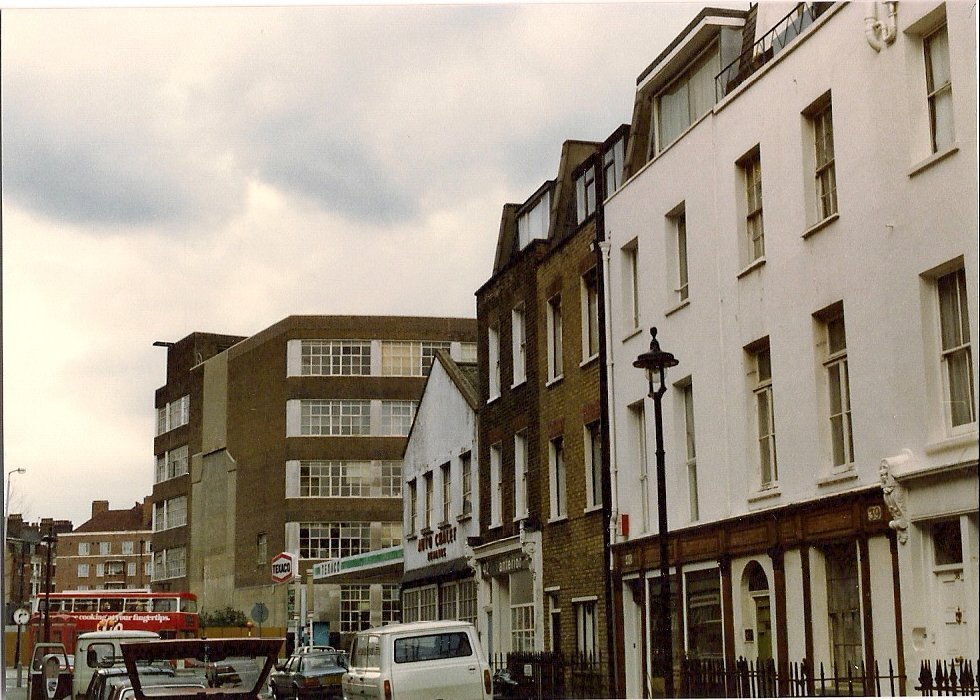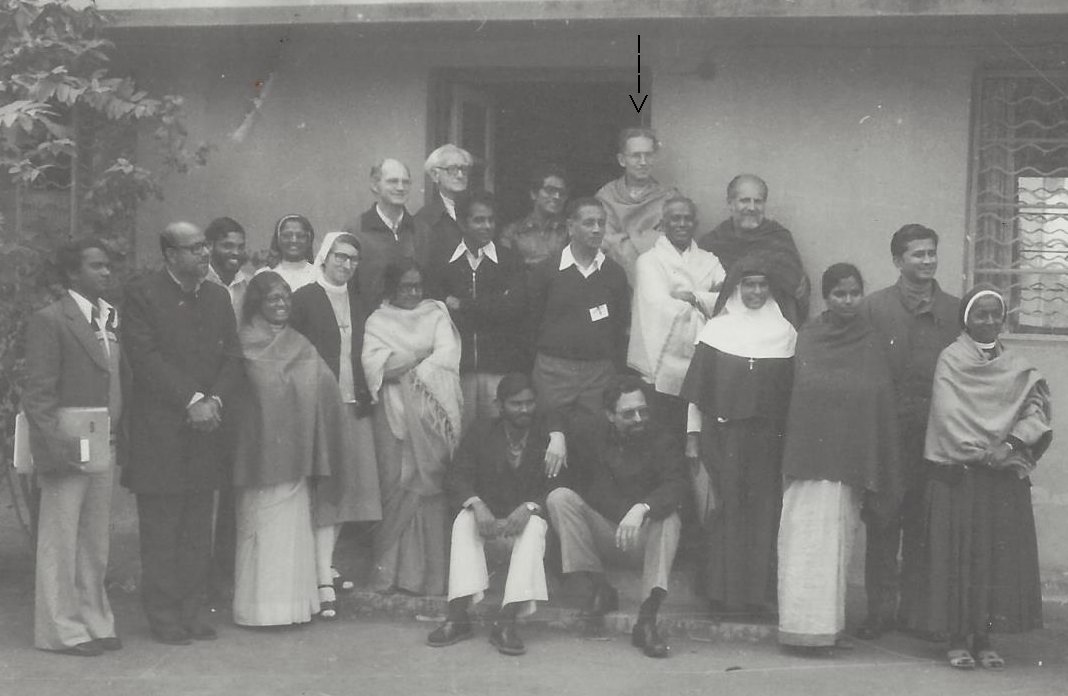Teaching in India and in the UK
After receiving my new appointment from Mill Hill, I set up a communication center in the middle of London from which I could operate. Through the good services of a friend, Mrs Erica Gibello, I secured a small but well located house near Paddington Station. I also was lucky enough to attract Jacqueline Clackson, whom I had got to know in India, as a team member. We decided to call the Center ‘Housetop’, referring to Jesus’ injunction that we should proclaim the good news ‘from the housetops’. In the course of time our team was expanded by voluntary workers who helped us by giving their energy and time.

Housetop Centre, Homer Street 10. Narrow, three floors up. Front door just opposite the lamp post
As I will explain in later chapters, our communication center was involved in a range of apostolic ministries. With the help of my team, I provided counselling to people who were caught in the new religious sects. I developed educational videos that could be used in parishes and schools. I wrote books and articles on biblical spirituality and church reform.
But meanwhile I also had a teaching job. The first part of the year, January – June, I travelled in India giving conferences, courses and retreats. From September to December I taught in the Missionary Institute London.
My Indian safaris
Tourists and business travellers could get a three-months’ residential visa for India. At the end of the three months it could be extended with another three months.
On such visas I spent the first half of each year (1984 -1990) in India. I used to have an extremely varied programme. A typical commitment would be giving a ten-day theological updating course to priests of a particular diocese. I gave such courses in Cuddapah, Nagpur, Kumbakonam and other dioceses whose names I have forgotten.
At other times the requirement would be seven-day retreats for religious or for diocesan clergy. Since India had 90,000 religious sisters at the time, and 100 dioceses, it took me up north like Bihar, Uttar Pradesh and Bengal, then down south to Tamilnadu and Kerala, that is: throughout India. Among other things, it gave me precious insights into the Catholic Church in India.
Also every year I would have regular slots for extended courses at the major renewal centers in India, such as the National Catechetical Biblical Centre and Sudeep in Bangalore, Jeevan Jyoti in Secunderabad, Mater Dei in Goa and Navsadhana in Varanasi on the banks of the Ganges.

Orchestrating a discussion . . .
My journeys through India offered a number of unexpected adventures. Once travelling from New Delhi our small Fokker aircraft lost a wheel in flight. After circling for a long time over Kanpur airport, it managed to land safely on one wheel . . . However, it took some days before another wheel had been brought in from elsewhere and we could continue our journey on the plane.
Another time, taking off from Pune to fly to Mumbai on my way to Ahmedabad, I was again in a small Air India Fokker plane. It was the monsoon period and our little 30-passengers aircraft was being tossed right and left in fierce winds. As I looked outside through a small side window, I observed mist and rain. The plane seemed to climb with difficulty. Then I suddenly saw walls of sheer rock rising up in front of us – they were part of the Western Ghats. My heart stopped beating. But the plane managed to surge up and emerge over the top. However two days later in Ahmedabad I read in the paper that another plane flying from Pune to Delhi had crashed into the mountain during a monsoon storm. Everyone on board died.
During a series of conferences in Calcutta I was supposed to stay in St Xavier’s Jesuit College, as I had done before. I had sent a telegram about my time of arrival, but the plane was much delayed. It arrived at the airport around 2 am and it took another hour for a taxi to take me to the College. The College was in total darkness and hermetically closed. All gates in the high perimeter wall were locked. Through gaps I could see ferocious guard dogs patrol the inner area. It took a long, long time before, via a microphone near the front gate, I had established contact with the Jesuit minister – who recognised me and let me in. The telegram only arrived next day.
During a thirteen-hour night journey in Eastern Tamilnadu I travelled in a small bus. Many were standing in the narrow passage way. I sat on a hard narrow bench, pressed on all sides by a mass of local men. It was very uncomfortable. Most were trying to sleep. But then I suddenly felt a hand slide under my belt, stroking my skin right down to my buttock and up along my back under my shirt. I froze. What to do? I could not even see who was doing this. I did not want to cause a disturbance and perhaps lose my seat. Why was the chap doing this? Was he gay and trying to make contact? In the end I firmly gripped his hand, squeezed it and turned it away. Peace returned . . .
Bishop Abraham Alangimattathil of Kohima in Nagaland invited me to give a course to his priests. I accepted. He told me that, because of some Naga tribes fighting a guerilla war against the Indian garrisons, outsiders needed special clearance from central government in Delhi to be permitted entrance. He told me that he would obtain such clearance for me. But when, in Delhi, I boarded the plane to Kohima security police warned me I needed the clearance. I told them it had been arranged. However, on arrival in Kohima I found out that the clearance had not come in time. I was promptly arrested. By interceding with the local governor, the bishop then managed to change it to ‘supervised house arrest’ in the bishop’s own mansion. All turned out well.

Me, under arrow, taking part in a conference of Catholic experts on Islam on dialogue with Muslims. The meeting took place in Patna.
I fine-tuned my lectures to their specific audiences. These included priests, religious, lay people. On one occasion three of us, all scripture experts, gave a one-week course to nine Indian bishops. The course was conduced in secret: no one should know that – goodness gracious! – even bishops needed instruction! We updated the bishops on the correct principles of interpreting the Bible. While my companions were more diplomatic, I went out of my way to debunk popular myths. It resulted in much frank talk and heated exchanges. But in the end even the most traditional bishop confided to me that he ‘had learnt a lot’ and that he preferred my ‘shoot-down-the-barrel’ style to the soft peddling adopted by the other lecturers.
My courses dealt with a vast range of topics, from understanding Sacred Scripture to how to be a good spiritual leader. To get a flavour of some of this material, I recommend that you read these four articles I published in the Indian clergy magazine Vidyajyoti:
- Leadership that fosters growth
- Helping people believe in themselves
- The pedagogy of love
- Open accountability
The Missionary Institute
The Missionary Institute London had been founded in 1968 as a collaboration between missionary societies, such as Mill Hill, the Missionaries of Africa, the Divine Word Fathers, the Comboni Fathers, the Milan Fathers and others. The institute was physically located in Holcombe House, Mill Hill. It brought students together, not only from European countries, but also from many African and Asian nations. The institute was affiliated to both Middlesex University and the famous Catholic University in Belgium, Louvain.
During the first semester of each year, that is from September to December, I taught at the institute as a professor of Sacred Scripture. My subject was mainly the letters of St Paul. I presented these in three main sections: General Introduction, Paul on Justification (Galatians and Romans) and St. Paul’s Sources (to disprove Rudolf Bultmann’s contention that not Jesus but Paul was the true inventor and founder of Christianity).
I tried to ensure maximum participation by the students through inserting debates within my lectures and by giving them essays to do which were both instructive and relevant to contemporary issues.
THE STORY OF MY LIFE
- » FOREWORD
- » Part One. LEARNING TO SURVIVE
- » origins
- » into gaping jaws
- » from the pincers of death
- » my father
- » my mother
- » my rules for survival
- » Part Two. SUBMIT TO CLERICAL DOGMA — OR THINK FOR MYSELF?
- » seeking love
- » learning to think
- » what kind of priest?
- » training for battle
- » clash of minds
- » lessons on the way to India
- » Part Three (1). INDIA - building 'church'
- » St John's Seminary Hyderabad
- » Andhra Pradesh
- » Jyotirmai – spreading light
- » Indian Liturgy
- » Sisters' Formation in Jeevan Jyothi
- » Helping the poor
- » Part Three (2). INDIA – creating media
- » Amruthavani
- » Background to the Gospels
- » Storytelling
- » Bible translation
- » Film on Christ: Karunamayudu
- » The illustrated life of Christ
- » Part Three (3). INDIA - redeeming 'body'
- » spotting the octopus
- » the challenge
- » screwed up sex guru
- » finding God in a partner?
- » my code for sex and love
- » Part Four. MILL HILL SOCIETY
- » My job at Mill Hill
- » The future of missionary societies
- » Recruitment and Formation
- » Returned Missionaries
- » Brothers and Associates
- » Part Five. HOUSETOP LONDON
- » Planning my work
- » Teaching teaching
- » Pakistan
- » Biblical Spirituality
- » Searching God in our modern world
- » ARK2 Christian Television
- » Part Five (2) New Religious Movements
- » Sects & Cults
- » Wisdom from the East?
- » Masters of Deception
- » Part Five (3). VIDEO COURSES
- » Faith formation through video
- » Our Spirituality Courses
- » Walking on Water
- » My Galilee My People
- » Together in My Name
- » I Have No Favourites
- » How to Make Sense of God
- » Part Six (1). RESIGNATION
- » Publicity
- » Preamble
- » Reaction in India
- » Mill Hill responses
- » The Vatican
- » Part 6 (2). JACKIE
- » childhood
- » youth and studies
- » finding God
- » Mission in India
- » Housetop apostolate
- » poetry
- » our marriage
